Main principles of sedimentology
GUY BERTHAULT
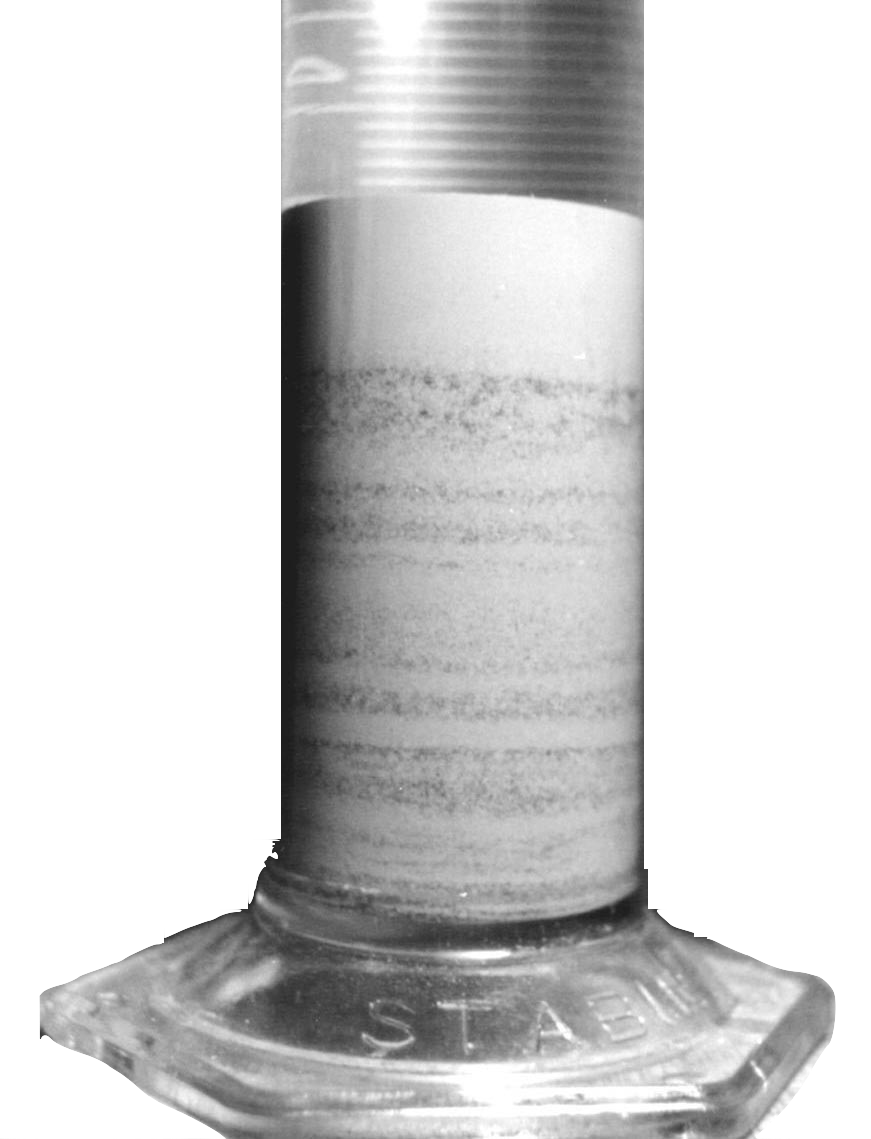
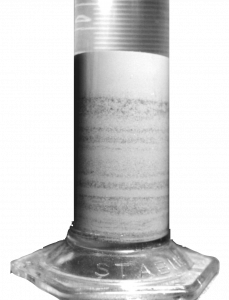
Context
Problems
This model based upon a postulate, which takes into account only one particular case of sedimentation – the absence of current, implying succession of time on a global scale, according to the vertical sequence of strata is not in accordance with experimental and field investigations.
The first part of the definition of the principle of superposition is: At the time when one of the highest stratum formed, the stratum underneath it had already acquired a solid consistence. A stratum between 50 cm and 1 m is considered thick. Consequently, submarine drillings should encounter solid strata in the stratified oceanic sediments after a few meters.
The results of sea bottom drilling showed that the first semi-consolidated sediments appeared about 400-800 metres (in depth). The isolated instances of certain beds of chert (siliceous beds) have been found under 135 metres of sediment near the zones of the oceanic transform faults (Logvinenko, 1980). Stenon’s definition, therefore, relative to successive hardening, which extends greatly the total length of time of deposition, is not supported by the sedimentological observations mentioned above.
Animation 1 (no sound)
No sedimentary layer goes all around the Earth. Seismic readings and sub-marine coring demonstrate that the strata in ocean deposits are not always horizontal and the rate of sedimentation is not uniform on a global scale of the Earth’s oceans.
In the first part of the definition for the principle of continuity Stenon affirms that: Strata owe their existence to sediments in a fluid.
Stenon says nothing about the action of the fluid on sediments, so that the relative stratigraphic chronology resulting from his principles did not take it into account (the two later principles of paleontological identity and uniformitarianism changed nothing in this respect). Currents exist in present day oceans, which erode, transport, and deposit sediments, as shown by Straknov in 1957. Geologists have attributed the change in orientation of stratification and erosion surfaces in sedimentary rocks to marine transgressions and regressions. This is the object of study in sequence stratigraphy today. Diagrams in this latter discipline, however, give no indication of the current velocity of these transgressions and regressions, only variations in the level of the oceans. Detrital sedimentary rocks alone (resulting from mechanical desegregation) would have required a minimum current to transport the particles from where they were eroded to their sedimentation site.
Charles Lyell added a principle of uniformitarianism, giving as an example layers deposited in fresh water in Auvergne. Observing that the layers were less than 1 mm thick, he considered that each one was laid down annually. At this rate, the 230-m-thick deposit would have taken hundreds of thousands of years to form. In the next section I show that these layers, which are laminae, do not always corresponded to annual deposits and may be generated in a time interval much less that the modern geological time-scale indicates.
Experiments & Videos
Major stages of the laboratory research
Two principal stages of the program dwelt upon the following two lines of research: lamination (Fig. 1) and stratification (Figs. 2, 3).
The following abstract of my paper (Berthault, 1986) provided the basis of my research on the deposit of heterogranular sediments in water, with and without a current.
These sedimentation experiments have been conducted in still water with a continuous supply of heterogranular material. A deposit is obtained, giving the illusion of successive beds or laminae (Fig. 1).
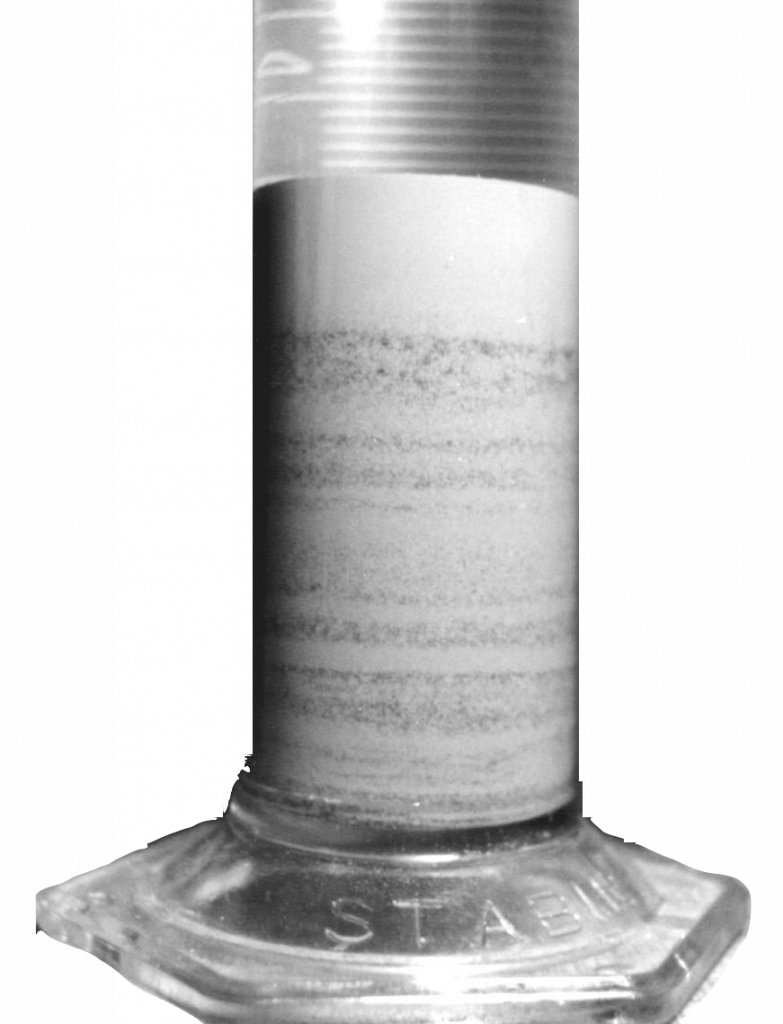
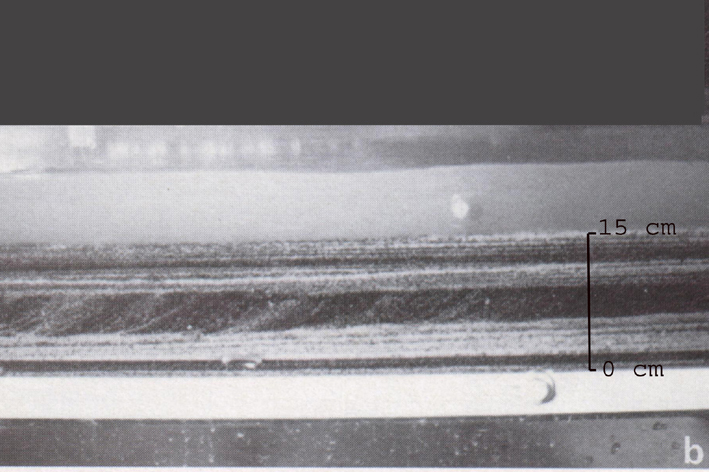
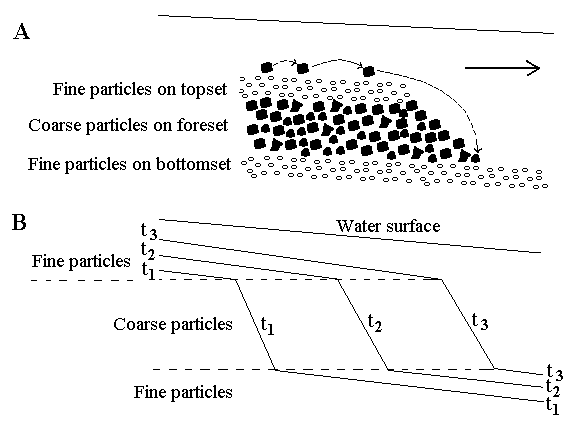
These laminae are the result of a spontaneous periodic and continuous grading process, which takes place immediately, following the deposition of the heterogranular mixture. The thickness of the laminae appears to be independent of the sedimentation rate but increases with extreme differences in the particle size in the mixture. Where a horizontal current is involved, thin laminated layers developing laterally in the direction of the current are observed.
Video 1 : lamination (no sound)
Video 2 : Fort Collins hydraulics laboratory (no sound)
Stratification
Experiments in stratification were conducted in the Fort Collins hydraulics laboratory of the Colorado State University with professor of hydraulics and sedimentology Pierre Julien (Video 2 : Fort Collins hydraulics laboratory).
For these, it was necessary to operate with water in a recirculating flume traversed by a current laden with sediment. As Hjulstrom (1935) and his successors had defined the critical sedimentation rate for each particle size, the current velocity would need to be varied. By modulating the current velocity, a superposition of segregated particles could be obtained.
The flume experiment showed that in the presence of a variable current, stratified superposed beds prograde simultaneously in the direction of the current (Fig. 2) – (Video 3)
Video 3 (no sound)
The result, on the scale of strata, is also conform, on the scale of facies (Video 4) to Golovkinskii, Inostranzev and Walther’s law (Walther, 1894 ; Middleton, 1973; Romanovskii, 1988), according to which the extension of facies of the same sequence is the same both laterally and vertically (video 5).
Video 5 (no sound)
Video 6 (no sound)
The report of the experiment entitled Experiments in Stratification of Heterogeneous Sand Mixtures was published in (Julien et al., 1993).
This experimental study examines possible stratification of heterogeneous sand mixtures under continuous (non-periodic and non-interrupted) sedimentation. Three primary aspects of stratification are considered: lamination, graded beds, and joints.
(1) Experiments on segregation of eleven heterogeneous mixtures of sand-sized quartz, limestone and coal demonstrate that through lateral motion, fine particles fall between interstices of the rolling coarse particles. Coarse particles gradually roll on top of fine particles and microscale sorting is obtained. Microscale segregation similar to lamination is observed on plane surfaces, as well as under continuous settling in columns filled with either air or water.
(2) The formation of graded beds is examined in a laboratory flume under steady flow and a continuous supply of heterogeneous particles. Under steady uniform flow and plane bed with sediment motion, coarse particles of the mixture roll on a laminated bed of mostly fine particles. In non-uniform flow, the velocity decrease caused by tail-gate induces the formation of a stratum of coarse particles propagating in the downstream direction. On top of this cross-stratified bed, fine particles settle through the moving bed layer of rolling coarse particles and form an almost horizontally laminated topset stratum of finer particles. A thick stratum of coarse particles thus progresses downstream between two strata of laminated fine particles, continuously pro-grading upward and downstream.
(3) Laboratory experiments on the desiccation of natural sands also show preferential fracturing (or joints) of crusty deposits at the interface between strata of coarse and fine particles.
Rather than successive sedimentary layers, these experiments demonstrate that stratification under a continuous supply of heterogeneous sandy mixtures results from segregation for lamination, non-uniform flow for graded beds (Fig. 4). Superposed strata are not, therefore, necessarily identical to successive sedimentary layers.
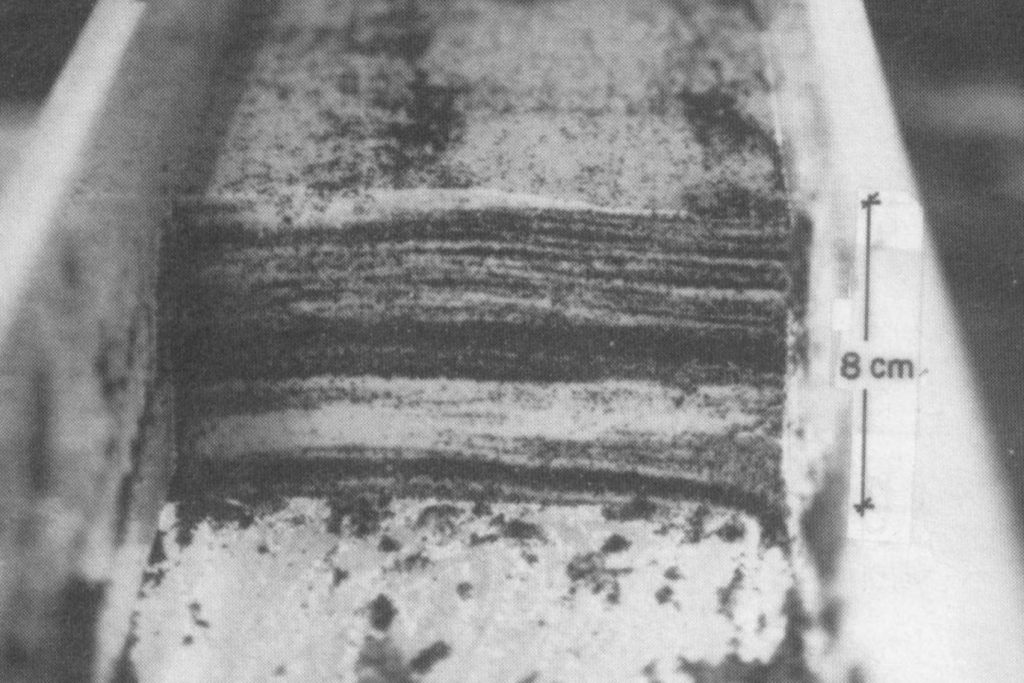

Our flume experiments demonstrated that Stenon’s assumption (strata are ancient successive sediments) and his principle of superposition can only apply in the absence of a current (transport velocity nil). Moreover, the experiments reported in my second paper to the Academy of Sciences and experiments conducted by P. Julien and presented by video Fundamental Experiments on Stratificationat several sedimentological congresses clearly show that up to the limit of the angle of repose (30o to 40o for the sands), the lamination of the deposit is parallel to the slope (Fig. 6)
Video 7 (no sound)
Video 8 (no sound)
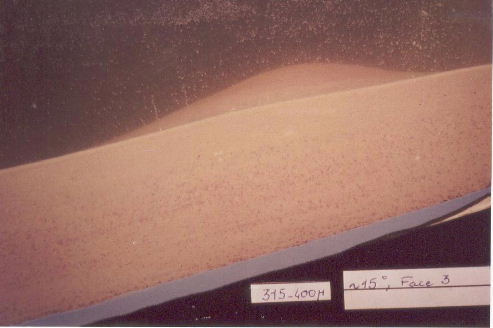
Paleohydraulic Analysis
Paleohydraulic conditions
Analysis of the main principles of stratigraphy on the basis of experimental data is necessary to determine the hydraulic conditions that existed when the sediments, which have become rocks, were deposited.
In this respect, the relation between hydraulic conditions and configuration of deposits (submarine ripples and dunes and horizontal beds) of contemporary deposits have been the object, especially recently, of well-known observations and experimentation. Examples are works of Rubin (Rubin and McCulloch, 1980) (Fig. 7) in a sea environment (San Francisco Bay) and Southard (Southard and Boguchwal, 1990) (flume experiments).
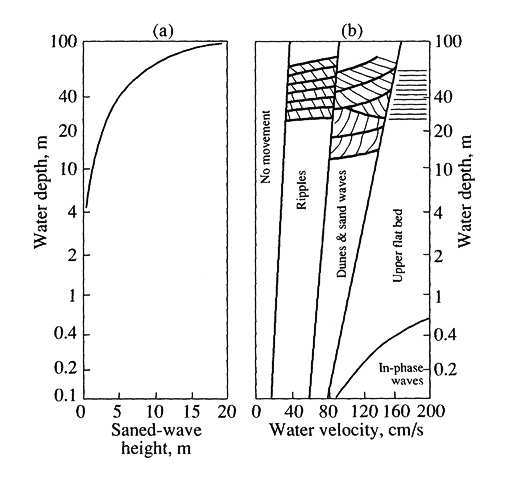
Fig. 7. Graphs of
(a) water depth vs. sand-wave height and
(b) water depth vs. water velocity, showing bedforms in fine sand expected under different water conditions.
The thickness of cross beds observed in fine-grained sandstone is used to estimate sand-wave height. Then, sand-wave height is entered into the graph
(a) to estimate the water depth where the sand wave formed. After a water depth is estimated on graph (a), the depth is transferred to graph (b), where the minimum and maximum velocities of water are indicated for the specific water depth.
Video 1 (no sound)
Table. Maxima permissible velocities or non-erosive for non-cohesive grounds, in m/s (selon Lischtvan–Lebediev)
| Average diameter of particles, in mm | Average flow depth, in m | |||||
| 0,40 | 1,0 | 2,0 | 3,0 | 5,0 | >10 | |
| –
0,005 0,05 0,25 1,0 2,5 5 10 15 25 40 75 100 150 200 300 400 >500 | –
0.15 0.20 0.35 0.50 0.65 0.80 0.90 1.10 1.25 1.50 2.00 2.45 3.00 3.50 3.85 | –
0.20 0.30 0.45 0.60 0.75 0.85 1.05 1.20 1.45 1.85 2.40 2.80 3.35 3.80 4.35 4.75 | –
0.25 0.40 0.55 0.70 0.80 1.00 1.15 1.35 1.65 2.10 2.75 3.20 3.75 4.30 4.70 4.95 5.35 | –
0.30 0.45 0.60 0.75 0.90 1.10 1.30 1.50 1.85 2.30 3.10 3.50 4.10 4.65 4.90 5.30 5.50 | –
0.40 0.55 0.70 0.85 1.00 1.20 1.45 1.65 2.00 2.45 3.30 3.80 4.40 5.00 5.50 5.60 6.00 | –
0.45 0.65 0.80 0.95 1.20 1.50 1.75 2.00 2.30 2.70 3.60 4.20 4.50 5.40 5.90 6.00 6.20 |
Time of Sedimentation
A team of Russian sedimentologists, directed by Alexander Lalomov (Russian Academy of Sciences, Institute of Ore Deposits) applied paleohydraulic analyses to geological formations in Russia. One example was the publication of a first report in 2007 by the “Lithology and Mineral Resources”, journal of the Russian Academy of Sciences. It concerned the Crimean Peninsular. It showed that the time of sedimentation of the sequence studied corresponded to a virtually instantaneous episode, whereas according to stratigraphy it took several millions of years. Moreover, a second report concerning the North-West Russian plateau in the St. Petersburg region shows that the time of sedimentation was much shorter than that attributed to it by the stratigraphic time-scale: 0.05% of the time.
The third report concerning the the Ural determines equally the time of sedimentation.
I concluded an agreement with the Institute of Kazan for the Moskovite team of sedimentologists to determine the paleohydraulic conditions of the local transgressive sequence studied in 1868 by Golovkinskii, founder of sequence stratigraphy.
This forth report determines equally the time of sedimentation.
We presented their report to the 33rd International Congress of Geology held in Oslo in August 2008, and in Ekaterinburg (Russia), in October at the 5th Conference on Lithology.
A new series of experiments was arranged with the St. Petersburg Institute of Hydrology to study erosion of different types of rocks (sandstone, limestone) at higher velocities of water current up to 27m\s to ascertain their rate of erosion over time and to provide the formation of conglomerates, to know the critical velocity of erosion of conglomerates seen in sandstone at the base of transgressive sequences. Initially, the water current was parallel to the surface plane of the sedimentary sample. The results show that at a velocity of around 25m\s, erosion was nil; where the period of the experiment was less than an hour. However, when the period reached 18h the erosion was around 2 grams. Experiment 25 was done with a sample whose surface was at an angle of 2.5 degrees to the direction of the current. In this case erosion reached 6.6g. in 18h.
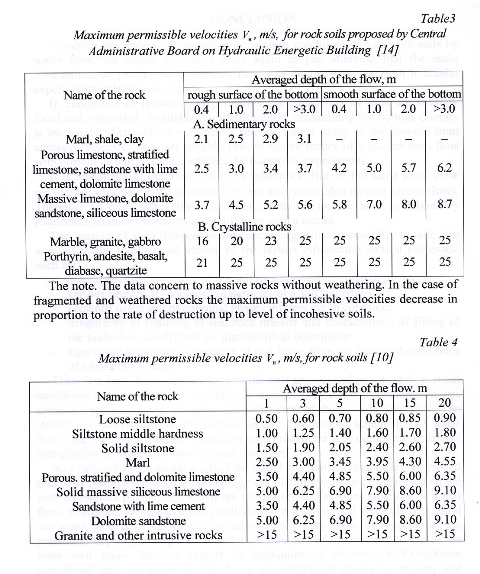
Addendum
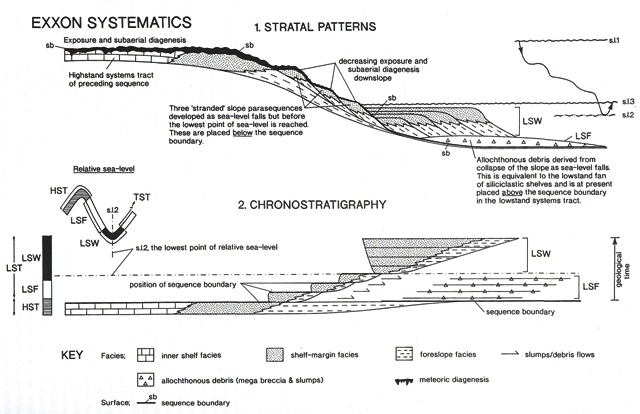
Apart from sedimentology, there is another important subjects which I think are relevent.
Radiometric Dating
The second concerns radiometric dating. Brent Dalrymple, a leading specialist in K/Ar dating has given examples of several volcanoes where the year of eruption is historically known and where the K/Ar dating is completely divergent.
In 1996 American Geologist Steven Austin agreed to use this method to date the late eruption of Mt. St. Helens which occurred in 1986. He took a sample of the dacite from the cone of the eruption, reduced part of it to its component parts and sent them, together with the whole-rock, to an American laboratory for dating. The results were published by CEN Tech. J. , vol. 10, n3, 1996 :
Ar (ppm) | |
dacite 350.000 years | 0,0018 |
feldspar 340.000 years | 0,0024 |
amphibole 900.000 years | 0,0027 |
pyroxene 1.700.000 to 2.800.000 years | 0,0015 to 0,0025 |
according to the model age equation.
The report says “these ages, of course, are preposterous. The fundamental dating assumption (no radiogenic argon was present when the rock formed) is questioned by these data. Instead data from the Mt. St. Helens dacite, argue that significant “excess argon” was present when the lava solidified in 1986. Phenocrysts of orthopyroxene, hornblende and plagioclase, are interpreted to have occluded argon within their mineral structure deep in the magma chamber and to have retained the argon after emplacement and solidification of the dacite. Orthopyroxene retains the most argon, followed by hornblende, and finally plagioclase”.
The presence of abundant argon deep in the rocks produced at the time of the eruption (recent or ancient) and which rises towards the surface of the magma, gives the impression the rocks are older than they are when dated by the potassium/argon method.
The fact that the method has been used to date the Australopithecines raises the question: what then is their real age?
This fundamental dating assumption, as regards other radiometric dating is also questioned, because every sample rock contains a quantity of daughter resulting from the decay of the parent in the lava, before crystallisation, which makes the rock appear older. The model age equation requires that the initial number of daughter atoms be known. No analytical equipment, however, can give this value.
The isochron age equation depends on several assumptions, the principal being that rocks of a same formation, when they formed, had the same abundance of daughter, in this case argon. This is not so for the dacite and its components mentioned above which only ten years after the eruption showed different respective quantities of argon.
The model age so determined corresponds to magma and not crystallisation (as for the dacite). Moreover, gravitational settling between minerals exists in the cooling magma. For example, strontium, which has the same valence and very similar ionic radius substitutes for calcium. So in fact, since plagioclase which carries strontium is less dense than olivine, then due to gravitational settling in an intrusion the greatest quantity of plagioclase and therefore strontium can sometimes remain in the higher levels of that intrusion. So strontium can be more abundant at a higher level in a magma intrusion which gives an apparently older age.
In conclusion the radioactive age does not necessarily refer to the crystallisation of rocks and consequently not to geological dating.
Contact
- Guy Berthault
- 28 Boulevard Thiers
- 78250 Meulan
- France
Send Me a message
Papers
Berthault, G. : “Orogenesis: Cause of sedimentary formations” – Kazan Golovkinsy Stratigraphic Meeting, 2014, pp.19-20
Lalomov, A., Berthault G., Tugarova, M., Isotov V., Sitdikova L.: “Reconstruction of sedimentary conditions of Middle Permian Kama-Ural basin studied by N.A.Golovkinsky” – Kazan Golovkinsy Stratigraphic Meeting, 2014, pp.53-54
Berthault, G. : “Orogenesis: cause of sedimentary formations” – “Open Journal of Geology“ ISSN 2161-7570.Vol 3, Number 28, April 2013.
Berthault G. : “Towards a Refoundation of Historical Geology” – “Georesources” 1(12) 2012, p.38, 39
Berthault, G., Lalomov, A. V. and Tugarova, M. A. : “Reconstruction of paleolithodynamic formation conditions of Cambrian-Ordovician sandstones in the Northwestern Russian platform” – “Lithology and Mineral Resources, 2011, Volume 46, Number 1, 60-70” (Springer Publishing site)
Berthault, G., Veksler A.B., Donenberg V.M. , Lalomov A. : “RESEARCH on EROSION OF CONSOLIDATED and semi-consolidated SOILS BY HIGH SPEED WATER FLOW” Izvestia.VNIIG., 2010, Vol. 257, pp.10-22. – (Russian original.)
Lalomov, A. : “Reconstruction of Paleohydrodynamic Conditions during the Formation of Upper Jurassic Conglomerates of the Crimean Peninsula”, Lithology and Mineral Resources, 2007, Vol. 42, No. 3, pp. 268–280
Berthault, G : “Sedimentological Interpretation of the Tonto Group Stratigraphy (Grand Canyon Colorado River)” , Lithology and Mineral Resources 2004, Vol. 39, No 5. October 2004.
Berthault G., “Analysis of Main Principles of Stratigraphy on the Basis of Experimental Data”, Litol.Polezn.Iskop.2002, vol 37, no.5,pp 509-515 (Lithology and Mineral resources 2002 (fac-similé) (Engl.Transl.), vol.37, no.5, pp442-446), Journal of the Academy of Sciences of Russia.
Julien, P.Y., Lan, Y., and Berthault, G., “Experiments on Stratification of Heterogeneous Sand Mixtures”, Bulletin Société Géologique de France, 1993, vol. 164, no. 5, pp. 649–660.
Berthault, G., “Sedimentation of a Heterogranular Mixture. Experimental Lamination in Still and Running Water”, Compte rendu de l’Académie des Sciences 1988, vol. 306, Serie II, pp. 717–724.
Berthault, G., “Sedimentologie: Expériences sur la lamination des sédiments par granoclassement périodique postérieur au dépôt. Contribution a l’explication de la lamination dans nombre de sédiments et de roches sédimentaires”., Compte rendu de l’Académie des Sciences de Paris 1986 , vol. 303, Ser., 2, no. 17, pp. 1569-1574.
_______________________________
Lalomov, A. and Tugarova, M. A. : REPORT for 2008 joint research of Geological Laboratory ARCTUR (Moscow) and Lithological department of Geological Faculty of St.-Petersburg State University “RECONSTRUCTION OF PALEOHYDRAULIC CONDITIONS OF DEPOSITION OF PERMIAN STRATA OF KAMA REGION STUDIED BY GOLOVKINSKY”
Lalomov, A., Tugarova, M. A. and Platonov M. : REPORT on 2004-2005 joint research of Geological Laboratory ARCTUR (Moscow) and Lithological department of Geological Faculty of St.-Petersburg State University
“Research of paleohydraulic conditions and determination of actual time of sedimentation of Cambrian – Ordovician sandstones of St.-Petersburg region”.
Lalomov, A. : FINAL REPORT for 2006 – 2007 joint research of Geological Laboratory ARCTUR (Moscow) in co-operation with Institute of Geology of Ore Deposits Russian Academy of Science (IGEM RAS) and Research – Exploration Centre “Monitoring” (Khanty–Mansiisk, West Siberia) – “PALEOCHANNELS OF URAL FOLDED BELT AND PIEDMONT AREA: RECONSTRUCTION OF PALEOHYDRAULIC CONDITIONS”